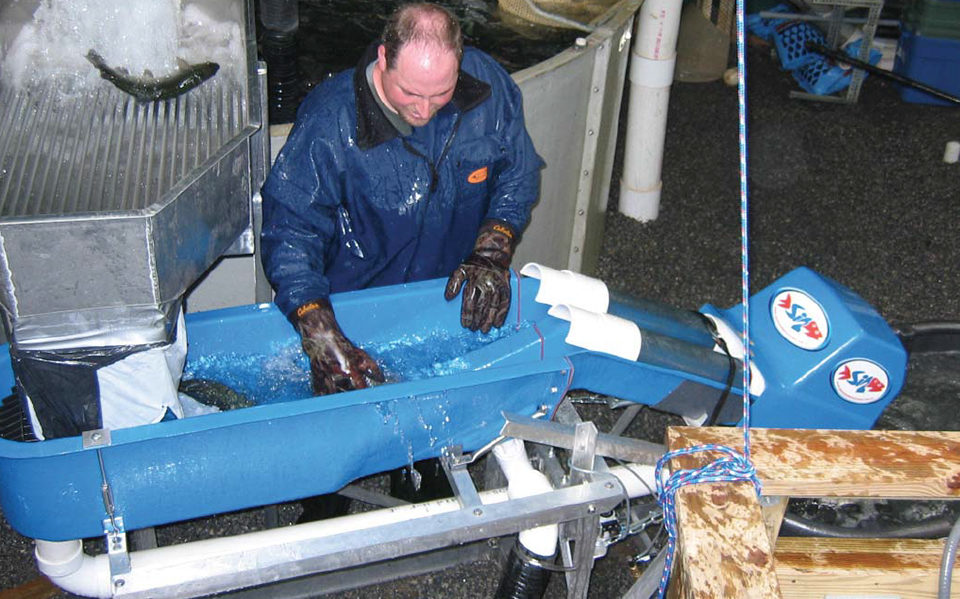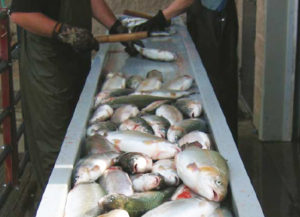Stun rates range between 90.7 and 96.3 percent

During the 2004-2005 period of production system research at the Conservation Fund’s Freshwater Institute in West Virginia, USA, almost 50 metric tons (MT) of rainbow trout were produced, harvested, and donated to the Virginia Food Banks Consortium. Initially, the 0.9-kg fish were killed by submergence for 10-15 minutes in an ice slurry containing a high level of dissolved carbon dioxide, followed by a manual blow to the skull.
The institute staff considered the ice slurry an acceptable method to euthanize fish quickly with minimal loss of end-product quality, as evidenced by a delayed onset of rigor and pH decline. However, observations of rainbow trout trying to flee the ice slurry tank indicated the technique was stressful to the fish and not as humane as desired. The technique was also labor-intensive, requiring the manual handling of fish into and out of the ice slurry.
For these reasons, researchers at the Freshwater Institute evaluated the performance of a prototype percussive stunning system for the slaughter of food-size rainbow trout with support from a U.S. Department of Agriculture, Agriculture Research Service grant.
Prototype stunner
The stunner was recently developed by Seafood Innovations of Brisbane, Australia, based on work with another unit designed to stun salmon of 1.5- to 15-kg size. This automated system has been successfully used in Canada, Australia and the United Kingdom.
The tested stunner was scaled to suit the trout, with the added efficiency of dual channels that allowed the enhanced throughput necessary to achieve suitable harvest efficiency with the smaller fish.
Institute staff evaluated the prototype stunner with two size groups of fish. For the smaller size, the vertical guides of the stunner were pulled far forward to better support the narrower fish. A fish orientation chamber induced the rainbow trout to swim head first into the slide channels that fed the stunner unit. Several trials led to an understanding of how to adjust the machine for fish of various sizes.
Results

In four trials of approximately 70 fish each, 426-gram fish were hand netted into the orientation chamber. From there, they swam into the slide channels, providing automatic delivery to the stunning chambers. Fish entering the stunner unit triggered a nearly instantaneous percussive blow from a pneumatically driven striker piston to the tops of their skulls.
The stunner was also tested during four harvests of 2 MT or less of 800- to 900-gram average rainbow trout that ranged in size from 0.4 to 1.4 kg. For these evaluations, clam-shell crowder gates guided the rainbow trout toward an air-lift pump intake in the circular depuration or grow-out tanks. The fish were pumped out of the crowding areas using a 20.3-cm-diameter air lift that incorporated a dewatering box to allow water to return to the fish tanks.
From the lift, the rainbow trout dropped into the fish orientation chamber. Although some of the trout self-oriented and swam head first into the slide channels, most of the larger fish were not able to readily turn within the orientation chamber. Therefore, one person manually pushed fish into the slide channels, achieving a sustainable stun rate of approximately 40 fish per minute.
During these latter trials, the prototype stunner provided stun rates of 90.7 to 96.3 percent (Table 1). It appeared that most of the unstunned fish passed through the unit upside down or tail first, or were the extremes in size. To accommodate their larger size, a wider orientation chamber will be fabricated to enhance automatic delivery of the 800- to 900-gram rainbow trout to the stunner.
Summerfelt, Stun performance of the prototype stunner, Table 1
| Harvest Date (2005) | March 21 | April 12 | April 27 | June 8 |
|---|---|---|---|---|
| Total fish weight (kg) | 1,830 | 1,992 | 663 | 653 |
| Mean individual fish weight (kg | 0.80 | 0.91 | 0.82 | 1.0 |
| Total fish | 2,275 | 2,205 | 805 | 653 |
| Stunned fish | 2,127 | 2,045 | 775 | 592 |
| Stunned fish (%) | 93.5 | 92.7 | 96.3 | 90.7 |
(Editor’s Note: This article was originally published in the December 2005 print edition of the Global Aquaculture Advocate.)
Now that you've finished reading the article ...
… we hope you’ll consider supporting our mission to document the evolution of the global aquaculture industry and share our vast network of contributors’ expansive knowledge every week.
By becoming a Global Seafood Alliance member, you’re ensuring that all of the pre-competitive work we do through member benefits, resources and events can continue. Individual membership costs just $50 a year. GSA individual and corporate members receive complimentary access to a series of GOAL virtual events beginning in April. Join now.
Not a GSA member? Join us.
Authors
-

Steven Summerfelt, Ph.D., P.E.
Conservation Fund’s Freshwater Institute
1098 Turner Road
Shepherdstown, West Virginia 25443 USA[103,114,111,46,101,116,117,116,105,116,115,110,105,114,101,116,97,119,104,115,101,114,102,64,116,108,101,102,114,101,109,109,117,115,46,115]
-
J. Bebak-Williams, VMD, Ph.D.
Conservation Fund’s Freshwater Institute
1098 Turner Road
Shepherdstown, West Virginia 25443 USA -
T.B. Waldrop
Conservation Fund’s Freshwater Institute
1098 Turner Road
Shepherdstown, West Virginia 25443 USA -
B. Goodrick
Innovations Pty. Ltd.
Sheldon, Queensland, Australia
Related Posts

Health & Welfare
Evaluating stunning methods in tropical shrimp aquaculture
Study evaluated effects of stunning methods (thermal shock and electric shock) on the welfare of three crustacean species, including Pacific white shrimp.

Health & Welfare
Fish producers benefit from humane slaughter techniques
EU legislation requires farmed fish be spared unnecessary pain, distress or suffering at slaughter, and efficient manual and automated systems have been developed to help achieve this goal. What’s more, longer shelf life and improved flesh quality have been reported.

Health & Welfare
Animal welfare: Growing factor in international aquaculture
Although concerns for the animal welfare of food animals are currently highest in the United Kingdom and European Union, they are also growing in other parts of the world.

Innovation & Investment
Global Aquaculture Innovation Award 2019 finalist: Ace Aquatec
Global Aquaculture Innovation Award finalist Ace Aquatec’s Humane Stunner Universal easily renders fish unconscious for a more humane slaughter process.


